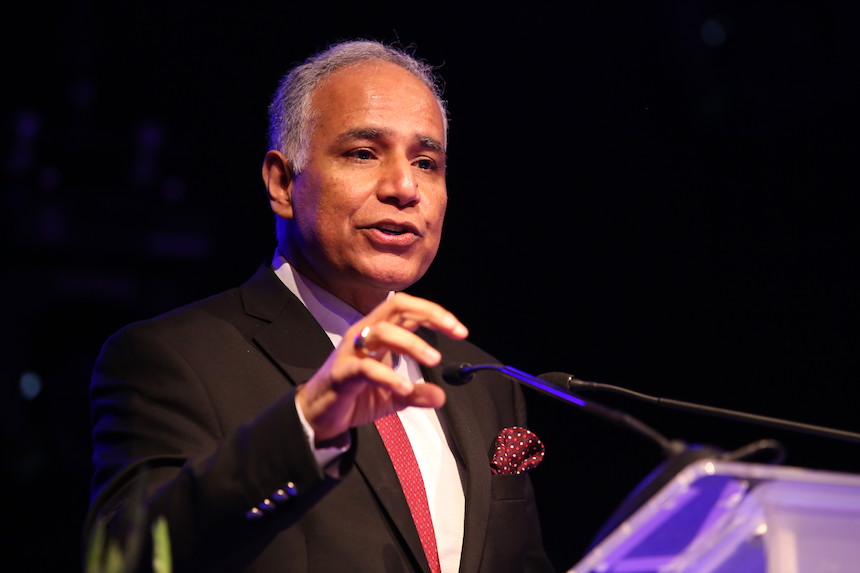Today, people across the United Kingdom are casting a vote that could change their country, but which could also transform European politics. The Remain camp claims that leaving the EU will be detrimental to Britain’s economy. Their opponents say the detriment to the UK of staying in the EU far outweighs the risks of leaving. They believe the Eurozone has been a disaster and maintain that it’s very important for Britain to regain control of their own borders.
Dr Arup Banerji, Regional Director for the European Union countries for the World Bank Group, talked to Andrew Wrobel about the impact of Brexit on Central and Eastern Europe. They also discussed other challenges that the European Union is currently facing that concern the CEE region and the solutions that might help address these.

It is literally the final countdown. Today Britons are choosing a future, not only for their country, but I would say for the entire continent. What impact do you think leaving the EU will have on Central and Eastern Europe?
What we do know now is that the prospect of Brexit is creating a lot of uncertainty. Neither the Leave camp nor the Remain camp knows the full impact of what might happen. Of course there are economic projections that have been made that show Britain will be worse off if it leaves.
As far as the Central and Eastern European countries are concerned, there are three possible channels where they might be affected. The first is trade. However, trade between the UK and any of the countries in CEE is relatively small, per se. As an example, for Poland it is a little bit over 2 per cent of their GDP. Countries will not be affected greatly in the pure trading channels, whether the UK stays or leaves, because the impact will be small on economic growth and prosperity.
The second channel is that of capital flow. Here the uncertainty actually matters and it is where the results will be asymmetric depending on whether Britain stays in, or leaves, the EU. If the UK stays the uncertainty will resolve itself quite quickly — at least as far as the acute uncertainty is concerned. However, if Britain leaves, and there follow protracted negotiations about Britain’s new relationship with the EU, then capital flows are much more likely to be affected by this uncertainty.
For the countries of CEE, the biggest question is what will happen to the labour flows. This includes the people who are already in the UK as well as those who would want to move there.
We already see preparations being made in the European institutions, including the European Central Bank and national governments, for “all possible contingencies” in the event of a UK vote to leave the EU. I think that causes extra stress. However, we are talking about Brexit and there are also a number of other important issues facing the EU now: the migrant crisis, economic disparities between the North and the South, the Eurozone crisis. Which of these is the most dangerous?
In terms of the economics, the biggest problem in our view is not actually the one that captures the headlines the most – such as immigration and refugees. It is the fact that Europe, and especially Western Europe and the Euro area, is stuck in a long-term slow-growth paradigm. That affects everyone. It affects exporters and it affects countries in CEE which are part of the value chain that is connected to Western Europe.
That is the single greatest threat, because this low-growth paradigm was assumed to be part of a cycle: recessions happen and then you recover. In fact most of the economic policies of the European financial authorities have been putting forward this idea: that, essentially, we have to make sure that we will survive the recession and should sow seeds for a regrowth. That regrowth is not happening – neither in the CEE region; in Europe; nor, in fact, in much of the rest of the world.
People talk now about a “secular stagnation” which is a long-time, low-growth, low-inflation environment. That is the threat. Even though countries in the CEE region are doing relatively well in terms of growth, the question remains as to where are the engines that will pull Europe and the rest of the world into a faster growth paradigm, so that income increases for all. Today, the traditional tools of economic policy are becoming increasingly less and less effective.

So which less orthodox tools should be used here?
The bottom line has to be increased productivity: how every European country uses its labour force.
Traditionally in a cyclical system, you use the tool of monetary policy to inject some credit into the economy in order to boost demand. Monetary policy, right now, has almost reached its limit because of the very low interest rates, which are almost negative in many countries. That has had limited effect.
Fiscal policy is also a traditional way of growing. You inject a lot of money into the economy and because of the subsequent investment spending and people’s consumption, the economy grows. Once again, because of the deficit ceiling that many countries are up against and because their deficits are too high, compared to the Maastricht and other prudence criteria (depending on the country), their ability to use fiscal policy is also fairly limited.
Therefore, the only way out is has to be through increasing the inherent dynamism of the economy and through unleashing productivity. That can only be done through innovation; by creating a lot of small, medium and large enterprises that use high levels of skills and thereby create higher wages and higher returns. That challenge is the singular greatest challenge facing all the European countries. To do that, reforms need to be made in the labour and product markets and there needs to be policies set up that can allow these high-functioning new enterprises to grow.
I think we are now living in a time where, in some cases, a few populist governments are in power, or are trying to take over the power, in the Old Continent and in the region also. Is there room for such an unorthodox approach?
I don’t think there is a contradiction between the populists’ stances and the fundamental reforms. The question is whether there is the desire to make some hard choices. Populist governments can are by definition popular and that offers space for reforms to be made. It’s a question of communicating why these reforms are needed, to the population, as well as why these reforms are important in terms of the future.
Essentially, I do see that there is a gap amongst generations, across Europe, and there is not enough understanding of what reforms may mean for young people. Today’s policies, across the Old Continent, favour the older segments of the population. They are already are well protected, having already benefited from the strong and powerful social policies that have created, if you like, this wonderful social pact in Europe.
But those same policies do not allow room for younger people to enter the labour force, to prosper or to have the same opportunities, for a future that the previous generations had. That is the crux of the issue: how do we make sure that there is a set of policies that both fulfils the social promise to the oldest generations but also allows the future that the young people need and want.
Let’s go back to the issue of the disparity between certain parts of the European Union and the Eurozone crisis. What is your view on that?
A large part of the Eurozone crisis, per se, if you think about it, has concerned the challenges around Greece and Southern Europe’s re-emergence. Much of the uncertainty around that has been resolved. It is a persistent problem, but one that doesn’t have a large spill-over right now, as opposed to a few years ago when were talking about Grexit.
The challenge to the Eurozone is actually the fact that the policy environment essentially handcuffs every country in terms of monetary-policy expansion. This is, of course, a challenge to any currency union that is the trade-off every country faced, and accepted, when adopting the Euro. There is also the fact that a traditional fiscal stimulus is difficult because there is such a large overhang of public debt. I return to my earlier point that demand-side stimulus, through monetary or fiscal policy is not sufficient, today, for economic dynamism.

Consider that when we look at Greece, more than 20 per cent of the population has been out of work for more than one year. Half of the young people have never had a formal job in their lives. So, even if there is a demand-led stimulus; even if through some miracle Germany, or China, or India, or the US becomes an external engine of growth and demand increases through trade, will an economy such as Greece have what we call the supply side ability to actually pull people into work? This is where some of the strongest structural programmes are needed.
The unemployment rate in Greece is very high, so is that country a good example in this case?
In a place like Greece you do need to have a tool to get young people and the long-term unemployed into the work force.
By the way, that is also true for Central and Eastern Europe, in general. Even though the region has been very successful economically over the last years, there are large pockets that lack the people who have the abilities to participate in this new dynamic part of the economy. We know that there are regions within these countries that are integrated with the rest of the world, that are fats growing and that are generating prosperity. Then there are other parties that are left out: regions, populations, and particular groups.
The challenge is that there isn’t an easy magic wand that can be waved – such as broad-based demand growth – that could lift those regions, where people are less advantaged and pull them to the forefront of the economy. Only activation programmes and other inclusion policies can be used to target those people and these regions, to make sure that they have the capability to participate in the economy.
Coming back to your question, for the Eurozone as a whole, the same metaphor holds for the north and the south. For the countries that are doing less well, there needs to be a set of policies that aims at their productivity; that aims at their abilities to participate on the supply side of the economy not just the demand side.
We haven’t tackled the social aspects yet, but before we continue with them, I would like to briefly ask you about the growth forecast for Central and Eastern Europe. Romania, Poland, Latvia and Lithuania are expected to be the best performing economies this year. How about the rest of the region?
I believe there is a lot of dynamism in this part of Europe. If you look at a heat map of growth in Europe, these are the bright spots, even though the figures for the first quarter of 2016 were a bit mixed. Poland’s first quarter performance was a bit disappointing but still showed a 3 per cent growth rate. When set into a broader EU context, this can be referred to as a bright spot and the World Bank maintains a 3.7 per cent forecast, for the country, for this year.
Overall, I think there is a lot of unused potential, in terms of investment needs and in terms of the structural reforms that are going on, that will continue to unleash the region’s potential. For example, Poland and Romania are countries that, if they continue their reforms, can help this potential to grow.
The challenge comes when we look at the actual growth and the economy’s underlying potential to grow. For this region, this is stuck at the 3 per cent rate, or a little higher. I say “stuck” because while that it seem good, compared to the rest of Europe, it should be higher because of the convergence challenge that this region is facing.
The whole idea of the European project was indeed to have these countries converged with Western Europe; with a 3 per cent growth rate. Full convergence is going to take decades of consistent growth in CEE, and perhaps consistent low-growth in the richer countries of Europe.
So, what is needed to increase investment potential?
We need to answer a few other questions before this one: firstly, are there better investment opportunities; is there more capital absorption; are there industries that can absorb this capital? Secondly, can there be more labour force participation? The region has a great challenge, here, as labour force participation is currently low; partly because of early retirement and partly because of a demographic decline. This creates a medium-term structural problem that is very hard to reverse in the short term.
Finally, the third element is the question of productivity. There is this amazing world of technology out there that has given us the opportunity to increase productivity. Can every part of the population in the CEE avail itself of these opportunities? I am not sure that the economies in the region are working as aggressively as they could to capture that.
Actually, a couple of years ago, Germany launched an entire policy debate about the fourth industrial revolution and about how policies and regulations need to be adapted in order to look forward five, or even ten, years. That debate poses these questions and tries to arrive at a social consensus about labour laws, industrial and manufacturing regulations and services’ regulations. Very few other countries have been this forward-looking about capturing the benefits of the new technological advances.

We’re circling back to the social progress that I mentioned before. Last year the UN adopted a set of goals to end poverty, to protect the planet, and to ensure prosperity for all. Aren’t we paying too much attention to economic growth while forgetting about the social aspects, such as basic needs, wellbeing and opportunities?
Let me focus on the last element you mentioned: opportunities. There should not be any inherent trade-off between economic well-being, or GDP growth, and social well-being, as long as everyone has the opportunity to avail themselves of opportunities to improve their welfare, as they see it, to the highest extent possible. That is what is really at the heart of the World Bank’s mission: to make sure that every person has the opportunity to make of themselves, and of their children, what they can. This is especially true for those in the bottom 40 per cent of the population and for those who suffer from extreme poverty – and there are such extremely poor people even in the CEE region.
The question is: does every part of the population have the opportunity to avail themselves of this? Are they limited, instead, by the level of their education, by their access to credit, or their location? That is the core question for our societies and policy-makers to address.
Do you mean that it is not that economic growth and social progress contradict one another but rather that they complement one another.
Very much so.


Add Comment